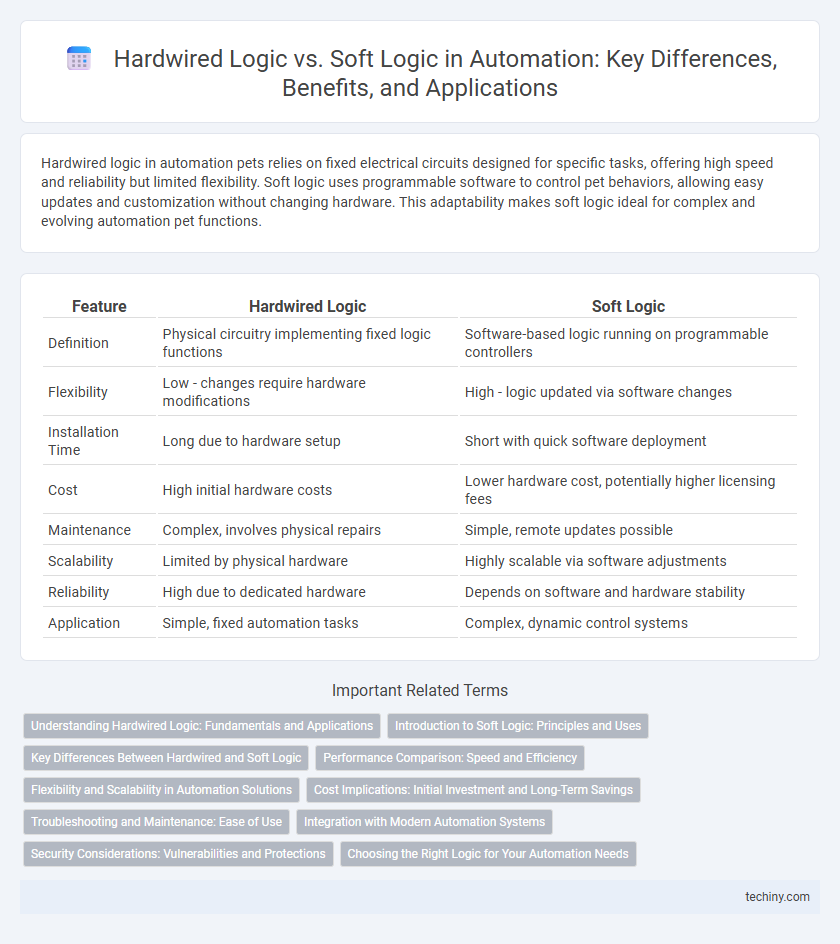Hardwired logic in automation pets relies on fixed electrical circuits designed for specific tasks, offering high speed and reliability but limited flexibility. Soft logic uses programmable software to control pet behaviors, allowing easy updates and customization without changing hardware. This adaptability makes soft logic ideal for complex and evolving automation pet functions.
Table of Comparison
| Feature | Hardwired Logic | Soft Logic |
|---|---|---|
| Definition | Physical circuitry implementing fixed logic functions | Software-based logic running on programmable controllers |
| Flexibility | Low - changes require hardware modifications | High - logic updated via software changes |
| Installation Time | Long due to hardware setup | Short with quick software deployment |
| Cost | High initial hardware costs | Lower hardware cost, potentially higher licensing fees |
| Maintenance | Complex, involves physical repairs | Simple, remote updates possible |
| Scalability | Limited by physical hardware | Highly scalable via software adjustments |
| Reliability | High due to dedicated hardware | Depends on software and hardware stability |
| Application | Simple, fixed automation tasks | Complex, dynamic control systems |
Understanding Hardwired Logic: Fundamentals and Applications
Hardwired logic employs fixed circuitry to perform specific logical operations, offering high speed and reliability in automation systems. It is predominantly used in applications requiring real-time processing and minimal latency, such as embedded controllers and industrial machinery. Understanding the fundamentals of hardwired logic is crucial for designing efficient automation solutions that prioritize deterministic behavior and hardware-level fault tolerance.
Introduction to Soft Logic: Principles and Uses
Soft logic utilizes software-based control algorithms executed on programmable controllers, enabling flexible and easily modifiable automation processes compared to hardwired logic's fixed circuitry. By embedding control functions in programmable logic controllers (PLCs) or industrial PCs, soft logic supports complex decision-making, real-time data processing, and seamless integration with higher-level systems like SCADA and MES. This adaptability facilitates rapid reprogramming, scalability, and improved maintenance efficiency, making it ideal for dynamic manufacturing environments and Industry 4.0 applications.
Key Differences Between Hardwired and Soft Logic
Hardwired logic uses fixed circuitry with dedicated pathways for specific functions, providing high-speed operation and reliability but limited flexibility. Soft logic is implemented through software and programmable devices, allowing easy updates and adaptability to changing requirements but typically resulting in slower execution speed. Key differences include hardware dependency in hardwired logic versus software configurability in soft logic, impacting system design, maintenance, and scalability in automation applications.
Performance Comparison: Speed and Efficiency
Hardwired logic circuits deliver superior speed and efficiency due to their fixed, dedicated pathways that minimize signal delay, making them ideal for time-critical automation tasks. Soft logic, implemented through programmable devices, offers greater flexibility but at the cost of slower processing speeds and increased resource consumption. In high-performance automation systems, hardwired logic outperforms soft logic by ensuring rapid execution and optimized power usage.
Flexibility and Scalability in Automation Solutions
Hardwired logic offers limited flexibility and scalability due to its fixed wiring and physical components, making it suitable for simple, repetitive automation tasks. Soft logic, implemented through programmable controllers and software, enables rapid adjustments and seamless integration of new functionalities, enhancing adaptability in dynamic industrial environments. Scalability in soft logic systems allows easy expansion and upgrades without extensive hardware changes, supporting growing automation demands efficiently.
Cost Implications: Initial Investment and Long-Term Savings
Hardwired logic systems typically require higher initial investments due to the need for specialized hardware and complex wiring, increasing upfront costs. Soft logic, implemented through programmable software on general-purpose hardware, reduces initial expenses and offers greater flexibility for updates and modifications. Over time, soft logic's adaptability leads to significant long-term savings by minimizing maintenance costs and enabling easy scalability.
Troubleshooting and Maintenance: Ease of Use
Hardwired logic systems require specialized knowledge for troubleshooting due to their fixed connections and complex wiring, often resulting in longer maintenance times and increased downtime. Soft logic utilizes programmable controllers that allow easier diagnostics and quicker updates through user-friendly interfaces, significantly reducing troubleshooting complexity. Maintenance of soft logic systems is more efficient as changes can be implemented through software adjustments without physical rewiring, improving overall operational flexibility.
Integration with Modern Automation Systems
Hardwired logic offers high reliability and speed but lacks flexibility when integrating with modern automation systems, which increasingly demand dynamic and scalable solutions. Soft logic, implemented through programmable controllers and software platforms, enables seamless integration with industrial IoT, cloud computing, and advanced analytics, facilitating real-time data exchange and adaptive process control. The compatibility of soft logic with multiple communication protocols and open architectures makes it the preferred choice for contemporary automated environments.
Security Considerations: Vulnerabilities and Protections
Hardwired logic circuits offer enhanced security through fixed, tamper-resistant pathways that minimize exposure to unauthorized code alterations, reducing vulnerability to cyberattacks. Soft logic systems, while flexible and easily reprogrammable, face higher risks from malware injections and code manipulation, necessitating robust encryption and authentication protocols to safeguard control processes. Implementing real-time monitoring and anomaly detection in soft logic environments strengthens protection against unauthorized access and operational disruptions.
Choosing the Right Logic for Your Automation Needs
Hardwired logic offers faster processing speeds and greater reliability for fixed, repetitive tasks, making it ideal for simple automation systems with defined, unchanging processes. Soft logic provides flexibility and ease of modification through software-based control, better suited for complex or evolving automation applications requiring rapid adjustments and integration with other digital systems. Understanding specific operational requirements and future scalability helps determine whether hardwired or soft logic optimally aligns with your automation goals.
Hardwired Logic vs Soft Logic Infographic

 techiny.com
techiny.com